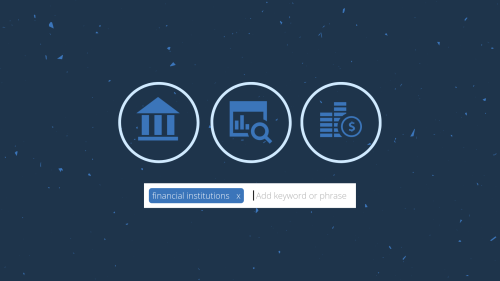In today’s fast-paced and interconnected global economy, effective marketing plays a significant role in the success of any financial institution or service provider. There are some fundamental characteristics when it comes to the marketing of financial services you should be aware of to help you navigate potential challenges and seize opportunities that come along the way.
? Read Creating a Marketing Strategy that Works: Benefits, Steps, Tools
Whether you’re a seasoned marketing professional working in the financial industry or a PR looking for guidance, you should be aware of the complexity of the promotion of financial services and products. That’s why it’s important to have your own go-to resource. We’ve compiled the most valuable strategies and insights to navigate you through the competitive world of marketing of financial services.

The Importance of Branding
Looking globally, the financial services market is expected to expand at an annual rate of around 10%. It’s a competitive world where customers entrust their hard-earned funds and financial stability to institutions and service providers, so building trust with the audience is of the essence. A strong brand and a solid foundation of trust are not only desirable but necessary for success in this industry.
Establishing Credibility and Differentiate
In an extremely overflowing market that is the world of finance, having a strong brand helps a company stand out from the crowd. It shows its credibility and expertise and reassures its customers that their financial needs will be met with professionalism and integrity. A well-defined brand identity that reflects the company’s core values and expertise helps differentiate a provider from the rest. It also creates a lasting impression in the minds of potential clients.
Building Emotional Connections
Financial decisions are often affected by emotions, ranging from security and stability to aspirations and goals. By developing a strong brand that resonates with customers on an emotional level, financial companies can forge deeper connections with their audience.
Mitigating Risk and Instilling Confidence
Trust is the foundation of any financial transaction, so customers need to feel confident about their provider. A reputable brand generates confidence and reduces perceived risk, leading to increased customer loyalty and advocacy.

Leveraging Digital Marketing of Financial Services
In today’s digital era, where technology and connectivity have transformed the way we interact and conduct business, leveraging digital marketing of financial services is crucial for achieving success and growth. It offers various opportunities where companies can reach and engage with their target audience, drive customer acquisition, and build lasting relationships. Let’s highlight the key strategies that can be used to maximize the impact of marketing.
Expanding Reach and Visibility
Digital marketing provides a vast platform to expand the reach and visibility of financial services. Through search engine optimization (SEO), pay-per-click (PPC) advertising, content marketing, and social media marketing of financial services, companies can position themselves in front of their target audience, ensuring their services are discoverable and attract potential customers.
Targeted Advertising and Personalization
Digital marketing enables precise audience targeting and personalized messaging. The best thing about this is that a company can leverage data analytics and customer insights in order to segment the audience and deliver tailored content. This level of personalization enhances the customer experience, increases engagement, and improves conversion rates. Using an AI writing assistant can also help shape the content in the right way and address the issues of the potential clients and answer their questions and concerns.

How to Target and Segment the Right Audience
To effectively market financial products or services, it is essential to identify and target the right audience. Understanding the needs, preferences, and demographics of the target market enables companies to tailor marketing efforts and deliver relevant messages. Here are some key considerations to keep in mind:
- One of the most important starting points is to conduct comprehensive market research to identify the target audience’s characteristics, behaviors, and preferences. It can be done by analyzing demographics, psychographics, and consumer trends to gain insights into their financial needs and pain points.
- The next important segment is dividing the target market into distinct segments based on common characteristics, such as age, income level, life stage, or financial goals. This segmentation allows the creation of targeted marketing campaigns that resonate with specific customer groups.
- Developing a buyer persona is another important segment. It is a fictional representation of an ideal customer. Keep in mind that each persona should encompass key details about their demographics, motivations, challenges, and goals. This helps understand the audience on a deeper level and tailor the messaging accordingly.

How to Craft Effective Messaging and Communication Strategies
The most successful organizations understand that their messaging must be tailored to the specific needs of their target audience in order to effectively reach their goals. So when crafting the messages aimed at a segmented target audience, a company should focus on what the potential clients are looking for and how the product or service can meet those needs. It’s important to use a language that resonates with their target market, whether it’s using more technical jargon for a sophisticated and experienced audience or simple terms for newcomers.
Use Digital Marketing Channels to Gain Advantage
There are several marketing channels and techniques that offer vast opportunities for financial service providers to reach and engage with their target audience. Consider the following:
- Content marketing is the cornerstone of organic traffic that shows long-term results. By creating and offering informative and educational content that addresses the audience’s financial needs and questions, a company will establish itself as the leading voice of the industry. Content may include blog articles, videos, e-books, and webinars.
- By implementing SEO or search engine optimization, a company will optimize the website and content for relevant keywords and phrases to improve organic search visibility. Using SEO techniques will immensely help rank higher in search engine results pages and drive targeted traffic to the website.
- Another important channel is PPC or pay-per-click advertising. A company can implement it using platforms like Google Ads or social media advertising to target specific keywords, demographics, and interests.
- Developing segmented email campaigns will nurture leads and maintain customer relationships. It should provide valuable content, personalized offers, and updates on relevant financial information. Keep in mind that automated email sequences will deliver targeted messages based on user actions and behaviors while the company focuses on other marketing strategies.
In the end, it’s essential to set clear objectives, design compelling ad copy, and monitor and optimize campaigns on the go for maximum impact.

Use the Power of Technology
Besides AI digital marketing tools and product development services a company can entrust to a third party, there are also other automation tools available. Other must-haves for financial service providers include CRM (Customer Relationship Management tools,) email automation, chatbots, and real-time analytics. However, even with the help of all these tools, there should be a comprehensive strategy in place. For instance, while the use of chatbots increased by 92% in 2019, 60% of users claim that they prefer to communicate with an agent.
To successfully adopt automation tools, it’s essential to cover some basic steps first. This includes evaluating and analyzing the existing customer base and setting aside a budget for the implementation of these tools. However, what’s also important is to understand the quality of gathered data and ensure that the company has enough resources to use the technology completely.
Marketing Analytics and Data Can Elevate Efforts
Understanding the ROI (return on investment) the marketing of financial services brings is easier with gathered data and analytics. Some reports have shown that the best-performing campaigns which exceeded growth intent by more than 25% were all data-driven. When it comes to financial service providers, this means integrating data gathered from social media, email, CRMs, and other channels to make a unified structure that provides valuable insights.

Unleash the Power of Marketing and Stand Out From the Crowd
Since the financial landscape in today’s world is fiercely competitive, standing out among the crowd is imperative for success. Harnessing the power of marketing has become a necessity for those looking to differentiate themselves and attract clients in an increasingly saturated market. By strategically employing innovative marketing techniques, such as personalized campaigns, establishing a brand through content creation, and building trust, a company can position itself as an industry leader.
Iva Jovanovic is an art historian by degree, a copywriter, and Mailtrap contributor by passion and profession. When she is not researching and testing new technologies or reading the latest news in marketing and tech, you can find her binge-watching TV shows, traveling, or just swimming in the nearest pool.






